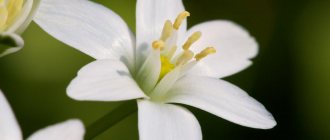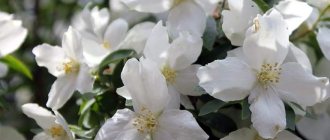Author: Elena N. https://floristics.info/ru/index.php?option=com_contact&view=contact&id=19 Category: Houseplants Published: February 27, 2019Last edits: January 11, 2021
- When to plant
- Growing conditions
- Bacopa caroliniana
plant (lat. Bacopa) belongs to the genus of the Plantain family, which includes more than 100 species of aquatic, water-loving, succulent creeping rhizomatous perennials. Bacopa is native to South America and the Canary Islands. In nature, bacopa grows on the marshy shores of reservoirs in the tropics and subtropics of Asia, Australia, America and Africa. The second name for bacopa is sutera. The bacopa flower has been in cultivation since 1993. It is also grown in temperate climates, using it as an ampel and as a ground cover plant.
Planting and caring for bacopa
- Flowering: abundant, gradually weakening, but then growing again.
- Planting: sowing seeds for seedlings - in March, planting seedlings in open ground or in hanging structures - in mid-May.
- Lighting: bright sun or partial shade in areas protected from strong winds.
- Soil: drained, humus-rich fertile soils with a slightly acidic reaction.
- Watering: frequent and plentiful, especially during drought.
- Feeding: Only young plants need feeding from spring to September. Complex mineral fertilizers are used in turn with organic ones.
- Pruning and pinching: for better tillering, shoots are pinched from time to time, and lashes that are too long are shortened. The plant is pruned when flowering becomes scarce and the lower part of the shoots becomes woody.
- Reproduction: by seeds, from January to April - by apical cuttings.
- Pests: at home - whiteflies, aphids and spider mites.
- Diseases: gray rot, sooty or mold fungus.
Read more about growing bacopa below.
Care errors and their elimination
Problems when growing Bacopa and methods for eliminating them:
| Problem | Causes | Solution |
| Pulling out shoots | Lack of lighting | Place the container with the plant in a bright place |
| Yellowing and falling leaves | Dry soil, dry air | The soil under bacopa should always remain moist; the leaves should be sprayed regularly to increase humidity |
| Darkening of shoots | Root rotting due to excess water in the soil | Do not waterlog the flower, drain excess liquid from the tray after watering |
Botanical description
The stems of bacopa are thin, creeping, creeping or lodging, reaching a length of 60 cm and growing greatly in width. The leaves are small, broadly elliptic or ovate, green or olive-green in color, linear, with a serrated edge. Ampelous bacopa blooms with axillary bell-shaped or tubular flowers (depending on the type and variety), small or large, simple or double, white, pink, lilac, blue, light blue, red, violet or lilac. Bacopa blooms for a long time and occurs in waves: after an abundant first wave, the formation of flowers dies out, and after a while it intensively resumes. The lifespan of the plant is short, but it reproduces easily. Cultivation of ampelous bacopa is carried out both in the garden and at home.
Types of Bacopa
The success of growing bacopa directly depends on the variety chosen.
Important. It is recommended to take seeds only from trusted sellers. Otherwise, there is a risk of purchasing low-quality outbred seeds.
Sometimes bacopa is cultivated as a hanging variety. Of the hanging varieties, the best varieties are blue bacopa, double snowball, spreading, pink avalanche.
The best traditional varieties include bluetopia, Vasilisa, and white terry bacopa.
After selecting seeds, you must carefully familiarize yourself with the selected variety and the characteristics of its cultivation.
Growing bacopa from seeds
How to sow seeds
For the primary cultivation of bacopa, you will have to resort to the seed propagation method. Growing bacopa from seeds does not involve any particular difficulties, and purchasing high-quality seed material in the store is not a problem. When to sow bacopa for seedlings? Sowing is carried out in March in a peat substrate sterilized for 4 hours in the oven at a temperature of 100 ºC, which, after cooling, is placed in a container with transparent walls. There is no need to bury the bacopa seeds; just press them to the surface of a moistened substrate and cover them with film or glass. Bacopa germinates from seeds in the light, at a temperature not lower than 20 ºC. Shoots can appear in 10-14 days, and the full germination period can last 3-4 weeks.
Seedling care
Caring for bacopa during the seedling period is simple. Once seedlings begin to emerge, it is important not to allow the substrate to dry out. Remember to carefully loosen the soil around the seedlings. At the stage of development of seedlings with three true leaves, the first picking of bacopa is carried out - transplanting the seedlings into separate peat pots with a diameter of 5 cm. After the seedlings have settled in the new place, they are fed with complex mineral fertilizer in half the dose recommended by the manufacturers. The optimal temperature for growing bacopa seedlings is 22-26 ºC.
- How to make a violet bloom for a long time - 3 conditions for long and abundant flowering of Saintpaulia
If you are going to plant seedlings in the garden, then most likely the bacopa seedlings will require a second picking - transplanting into larger pots, which, for the stability of the seedlings, is carried out with the stem buried by one node. A week after the second picking, when the bacopa seedlings have taken root, they are fed with complete mineral fertilizer with a predominance of phosphorus and nitrogen, after which the temperature in the room during the day is maintained within 15-24 ºC, and at night – about 13-15 ºC.
If you grow bacopa as a houseplant, then there is no need to carry out a second picking - the seedlings are immediately transplanted into a pot or basket.
Diseases and pests
If you violate the rules of agricultural technology, bacopa may be attacked by pests and get sick.
More often the plant is affected by fungal infections:
- sooty and mold fungus;
- gray rot.
If a problem occurs, it is recommended to thin out the crown of the plant and remove damaged areas. Apply 2-3 times of fungicide treatment at intervals of 10-14 days between treatments.
Bacopa pests:
- whitefly;
- aphid;
- spider mite
To get rid of parasites, the crop must be treated with an insecticide (Aktara, Karbofos, Fitoverm). To prevent infection, you need to regulate the care of the plant.
Planting bacopa in the garden
When to plant
Bacopa is planted in open ground as soon as the threat of return frosts disappears, that is, approximately in mid-May. But first, the seedlings must undergo hardening: they are taken out into the open air every day, gradually increasing the duration of the sessions until the seedlings can spend the whole day in the yard.
How to plant
Bacopa grows best in sunny areas protected from the wind. You can plant it in partial shade, however, the less sunlight the plant receives, the fewer flowers there will be. In the shade, bacopa generally loses its decorative properties - its shoots become elongated and few flowers are produced.
Bacopa is undemanding in terms of soil composition, but it is best suited to well-drained, fertile, humus-rich soils with a slightly acidic reaction. When planting in open ground, the distance between seedlings, depending on the variety, is kept within 10-25 cm - the taller the plant, the more space it will need.
Bacopa care in the garden
Growing bacopa in the garden involves performing such usual gardener activities as watering, weeding, loosening the soil, fertilizing, pinching and pruning, as well as protection from diseases and pests. There is no need to remove faded flowers - bacopa can clean itself. The plant needs to be watered frequently and abundantly, especially in dry, hot summers. After watering, you should lightly loosen the soil, being careful not to damage the surface root system of the plant. Weeds also need to be removed carefully, and it is better to do this manually.
- Kandyk
As for fertilizing, only young plants need them. Fertilizers are applied from spring to September, but as winter approaches, fertilizing is stopped. Fertilize bacopa with complex mineral solutions, alternating them with organic matter - solutions of bird droppings or mullein.
Bacopa flower
Bacopa inhabits the wet wetlands of the tropics of America, Africa and Australia. Her love for moisture remains in decorative growing conditions. Bright sunlight is needed for its abundant flowering, and moist soil for active growth of shoots.
Bacopa rosea
Small flowers cover the entire length of the shoots, which can grow up to a meter. Flowers in light, delicate shades - white, lilac, blue, violet, pink. Green or olive leaves are small, growing in pairs. Bacopa belongs to the plantain family.
Interesting to know! Other names for the plant are Vasora or Sutera.
The green beauty grows well both in open ground and indoors - on balconies and verandas all summer. The plant is unpretentious, active and healthy growth is maintained by observing only a few conditions:
- The lighting should be plentiful; the flower should receive a dose of direct sunlight every day. It should be planted in open ground in sunny and unshaded areas. Balconies and loggias also need good lighting.
- Water abundantly, but the soil should allow water to pass through well and not retain moisture in the roots of the flower. The soil in the pot should be constantly moist. For root respiration, it is important to loosen the soil after each watering, both in the pot and in the flowerbed.
- Fertilizer is necessary when propagating a flower, so that the roots become stronger during the period of active growth of greenery.
- The only requirements for soil are looseness and airiness. It should allow moisture and air to pass through well.
It is important to know! If there is a lack of light, bacopa will not bloom, although it will continue to grow. Many flower lovers are unknowingly in empty anticipation.
Diseases and pests with proper care practically do not affect the flower. Most often, the plant gets sick during wintering in room conditions, when the earthen clod is allowed to dry out, the temperature rises, or the humidity level decreases.
Bacopa care at home
Growing conditions
The conditions for growing bacopa in an apartment are not much different from those in the garden. How to grow bacopa indoors? The plant is planted in a substrate with approximately the following composition: humus, sand, garden soil and peat in a ratio of 2:2:1:1. The soil for ampelous bacopa should prevent waterlogging, since the fragile roots of the plant are prone to rotting, and that is why a thick layer of drainage material must be placed in the pot. Homemade bacopa, like garden bacopa, should be watered frequently and abundantly, but avoiding, however, long-term and chronic waterlogging of the soil, since this is much more dangerous than rare and insufficient moisture. After watering, the soil in the pots must be carefully loosened. Once every 10-14 days, liquid mineral fertilizer for flowering plants is added to the irrigation water so that the bacopa greens are always juicy and bright, and the flowering is abundant. The fertilizer solution is poured at the root, trying not to get on the leaves of the plant.
Accommodation
Bacopa at home, just like in the garden, requires good lighting and some direct sunlight every day. It grows well in partial shade, but if you place it away from the light, you may not wait for flowering. Since the plant normally tolerates temperature changes and even frosts down to -5 ºC, bacopa in a flower pot can decorate a balcony, terrace, veranda or loggia from spring to late autumn.
Trimming
In order for bacopa to bush well, the ends of its shoots are pinched from time to time, and if the lashes of the plant become too long, they are cut off. The apical cuttings remaining after pruning are used for propagation. Bacopa is also pruned when the lower part of its shoots begins to become lignified and flowering becomes scarce. In this case, the shoots are shortened by a third of their length, and it is better to do this pruning in the fall.
Pests and diseases
If care is improper or the growing conditions are not met, bacopa can be affected by gray rot, sooty or mold fungus, especially if the planting is too dense. If bacopa is damaged by fungi, its crown must be thinned out, and then the plant must be treated two or three times with a fungicidal solution at intervals of two weeks.
Among the pests, bacopa is affected by whiteflies, aphids and spider mites. All these insects are sucking, that is, they feed on the cell sap of bacopa, so they can be destroyed with acaricidal preparations in two or three stages.
Is it necessary to pinch Bacopa?
Pinching and pruning Bacopa stimulates its active growth and flowering. This procedure begins to be carried out even on seedlings.
It is important to know! If the flower is regularly pruned, the bush will send out lateral and root shoots more intensively.
Pinching is done so that the shoot awakens its lateral buds. The bush will be thick and dotted with flowers. Flowers grow not only on the axils of the shoot tips, so pinching will not harm the flowering at all, but will only stimulate it.
If ampelous Bacopa is planted, cultivation should be accompanied by pruning. It is necessary to cut off at least 1/3 of the length of the shoot. Cut shoots will become excellent material for further propagation. When forming the decor, you can leave several shoots long and cut others, creating interesting compositions.
A ball is most often formed from ampelous bacopa
On the soil, unpruned Bacopa will spread its shoots along the ground, but it is still worth pinching the beauty - the shoots will be thicker and bloom more luxuriantly.
Bacopa propagation
In addition to the seed propagation method, cuttings are used for propagating bacopa, for which apical cuttings about 10 cm long are used. They take root easily and quickly in moist, loose soil consisting of vermiculite and sand in equal parts. The cutting is buried 5 mm so that one node is underground - it will give new roots. The other node should remain above the surface of the soil - shoots will develop from it. The roots grow within 2-3 weeks, but to speed up root formation, it is advisable to treat the cut of the cutting with a growth stimulant or phytohormones. To create a greenhouse effect, the cuttings planted in the ground are covered with a transparent cap, and then placed in a well-lit place, protected from direct sunlight. During rooting, the soil should be slightly moist. When the cutting begins to form shoots, pinch it to encourage tillering.
- Rutabaga: growing from seeds in the garden, varieties
The best time for cuttings is from January to April - at this time, adult bushes are divided into cuttings. It is also good to root cuttings at the end of summer, when there is a lot of planting material left after pruning. Cuttings of white bacopa take root best; other types of plants are more capricious and require the use of drugs that stimulate root growth.
Reproduction methods
Suteru can be propagated in several ways.
Cuttings
It is better to harvest cuttings at the end of winter - beginning of spring. Take young shoots up to 10 cm long with 2 pairs of leaves. Remove the lower leaves. Place the cuttings in water with the addition of a growth stimulator (Kornevin or Heteroauxin) for several hours. Then deepen them into a moist, loose substrate for rooting. The area where the lower leaves grow should be sprinkled with soil. Cover the plantings with film on top. From time to time it must be removed for a short time to ventilate and moisten the substrate.
Remove the cover when the first young leaves appear on the cuttings. After the formation of 2 pairs of leaves, pinch the top to stimulate branching.
By layering
Place a container filled with substrate near the pot with the plant. Bend the branch and place it on the soil. Secure with a bracket. After some time, roots will appear on the layering. It can be separated from the parent bush. Further it will develop as an independent plant.
Seeds
Bacopa seeds are very small. Therefore, it is recommended to mix them with sand before sowing. Prepare a fertile, light substrate. Fill the container with it and moisten it. Distribute the seeds on top and press them slightly into the soil. Cover the crops with film to prevent moisture from evaporating. Transfer the container to a bright, warm place with a temperature of about +20 degrees.
After about 2 weeks, shoots will appear. After the formation of the first pair of leaves, the seedlings dive at a distance of 2 cm from each other, deepening the lower node into the ground. To grow seedlings, the temperature should be +23..25 degrees. When the seedlings are well established, they can be transplanted into separate containers. If you plan to further grow bacopa in open ground or on the veranda, then it is necessary to gradually harden the sprouts, accustoming them to natural aeration.
Perennial bacopa in winter
In the open ground or in the garden, perennial bacopa will not survive the winter, so with the onset of cold weather it must be brought into a room where there are no drafts, high air humidity and the temperature is maintained at 12-15 ºC. In winter, watering bacopa should be infrequent, since its growth stops. The wintering plant also does not need fertilizing.
Many gardeners do not plant perennial bacopa as a whole bush in the spring, since it still loses its decorative value over the winter. They take the overwintered plant into cuttings.
After pruning, homemade bacopa is also placed in cool conditions until spring. This could be a glazed balcony, loggia or unheated veranda or room.
Bacopa in the house: benefits and harm
The plant contains substances that have an anesthetic, antioxidant, anti-inflammatory, and sedative effect.
Bacopa helps:
- reduce cholesterol levels;
- strengthen the walls of blood vessels;
- stimulate collagen synthesis;
- neutralize pathogenic bacteria;
- improve memory;
- reduce anxiety.
The effectiveness of the plant is manifested only in combination with other medicines. Before using formulations with bacopa, you should consult your doctor. The plant has a number of side effects. It is prohibited for children under 16 years of age, pregnant and lactating women, and people suffering from hypertension. Culture reduces the ability of men to conceive. Bacopa should not be used simultaneously with sedatives.
Bacopa appeared in home cultivation quite recently, but has already gained popularity among gardeners. This is a beautiful moisture-loving plant that does not require complex care. The medicinal properties of the flower have not yet been well studied, but its decorative value is beyond doubt. Thanks to its long flowering, bacopa will decorate not only indoor spaces, but also verandas, balconies, loggias, gardens, and flower beds.
More useful information about growing, watering and spraying, maintenance temperature, as well as other nuances of caring for Bacopa can be found in the following video:
Types and varieties
In addition to the types and varieties of bacopa existing in nature, many varieties and hybrids have recently appeared, bred by breeders. The most popular of them in amateur gardening are:
Bacopa caroliniana
The plant is native to the eastern United States, reaching a height of 30 cm. It has thick, erect stems, planted in pairs with cross-shaped oval leaves, light green in the shade, and copper-red in bright sun. Small bright blue flowers open at the ends of the stems. This is aquarium bacopa - it is often grown in water under glass. In gardens, Carolina bacopa is planted along the banks of reservoirs, artificial or natural, or directly in them. The depth of the water in this case should be at least 30-35 cm;
Australian bacopa (Bacopa australis)
A low-growing plant with thin stems, growing in the water column. The shoots of Bacopa australis are covered with light green oval or rounded opposite leaves up to 18 mm long. The light blue flowers of the plant open on the above-water part of the shoots;
Bacopa monnieri (Bacopa monnieri)
Succulent with creeping stems, oblong sessile leaves from 8 to 20 mm long, entire or sparsely toothed and rounded at the apex. The flowers of this plant are axillary, with a blue, white or purple corolla up to 1 cm long;
Bacopa cordata
Herbaceous perennial up to 15 cm high with small or medium-sized green leaves;
Bacopa diffuses
Or beautiful (Bacopa speciosa) - a perennial plant from South Africa and the Canary Islands, originally with snow-white flowers that do not lose their decorative effect even during periods of prolonged rain. This plant is characterized by long flowering and the ability to self-clean - shed faded flowers.
The most famous varieties of spreading bacopa are:
- Snowflake is a variety of ampelous bacopa with an abundance of large white flowers;
- Cabana – large-flowered bacopa;
- Olympic Gold is a hybrid plant with shoots up to 60 cm long, white flowers and golden-green small leaves;
- Skopia Double Blue is a ground cover plant with large purple-pink flowers and bright green leaves;
- Blizzard is a plant with many small flowers;
- Rosea is a variety with pink flowers;
- Pink Domino is a plant with purple flowers;
- Taibun Blue is a variety of bacopa that blooms profusely with purple flowers.
In addition to those described, popular varieties of bacopa are Giant Cloud, Blue Showers, African Sunset and others.
Planting in open ground
What time to plant?
Bacopa is planted in open ground, usually starting in mid-May, when the soil has warmed up sufficiently and there is no threat of frost.
Before planting, seedlings are prepared - hardening procedures are carried out. To do this, pots of seedlings are taken out of the house every day, gradually increasing the time spent outside.
Rules of procedure
- Place : well-lit area, protected from gusts of wind.
- Soil : nutritious, with humus, slightly acidic, permeable to water and air.
- Distance between bushes : 25 cm in all directions. The distance increases depending on the height of the bush; the higher, the greater the distance.
Wintering of perennial crops
For the winter, perennial bacopa grown in open soil is dug up. Store for the entire period in a cool room at 12-15C with high air humidity. The plant should be protected from drafts. Watering is replaced by moistening and spraying the soil to avoid drying out. No fertilizing is needed in winter.
At the beginning of spring, cuttings are cut from the plant. They are rooted and planted in open ground.
When overwintering bacopa growing at home, it is cut off and placed in a cool place: loggia, glazed balcony, veranda - until spring.
Video about wintering Bacopa:
How to keep gerberas at home in winter
Gerbera loves light and warmth, so it is most often grown as a houseplant or greenhouse plant. If a flower has taken root in your garden and winter is ahead, try to save it. To do this, transplant the plant into a spacious pot and move it to the balcony or loggia. Gerbera will be able to survive at temperatures of 14-16°C, but not less than 12°C. When dormant, the plant still needs regular and not too much watering. It will also respond well to occasional spraying.
At the end of winter, begin to add light to the plant and gradually increase the storage temperature. Before planting in open ground, the plant can be divided into several bushes. And be sure to make sure that the soil has already warmed up and the place in the flowerbed is sunny and without stagnant moisture.
Bacopa and planting in the ground
Since the plant is heat-loving, it must be planted after all sub-zero temperatures have passed. As a rule, the second half of May is a suitable period.
Before planting greenhouse seedlings directly into the ground, they need to be prepared, for example, they can be taken out of the room onto the balcony so that the plants get used to a lower temperature threshold. Moreover, one day will not be enough; it is advisable to carry out such preparation for at least a week.
It is worth protecting bacopa from direct daytime sunlight so that aggressive lighting does not burn the flowers. But the calmer morning and evening sun will, on the contrary, have a beneficial effect on them.
Features of Bacopa
It is interesting that even with heavy rains, the shape of its flowers will not be damaged in any way, although the plant itself is fragile and requires a special approach in everything, starting with planting seeds.
Often photos of bacopa flowers can be seen precisely after rain, since the perception is created as if the plant had even more revealed the secrets of its extraordinary beauty.
Bacopa transplant
The root system of this plant tends to take up all the available space, so repotting must be done periodically when the roots emerge from the drainage holes.
The new pot should be wider and deeper than the previous one, and fertile soil, rich in organic matter and preferably mixed with a little sand.
To avoid the risk of root rotting, it is advisable to place a layer of coarse crushed stone or pieces of earthenware at the bottom of the pot. Planting in the ground is done in the same way; expanded clay or small gravel is poured under the roots.
What does bacopa look like?
This is a creeping herbaceous plant, the length of its shoots does not exceed 60 cm. The stems are drooping, flexible, thin and long, densely strewn with small flowers. They grow quickly on the soil surface, forming a dense carpet. The height of the perennial does not exceed 15 cm.
The leaves are miniature, oblong, ovate or broadly oval in shape. Their edges are covered with small serrations, the color of the leaf blade is pale green. The leaves grow in pairs and densely cover the shoot.
The plant blooms for a long time, abundantly from May to October.
The flowers are small, formed in the axils of the leaves. The corolla is regular in shape and consists of 5 petals fused at the base. The diameter of the flower does not exceed 2 cm. In its center there are short yellow stamens. Depending on the variety of bacopa, the color of the buds can be white, pink, red, blue, or lilac. After flowering, in place of the buds, small, dry, flattened boxes are formed, filled with a huge number of dusty seeds.
How to keep petunia at home in winter
Petunia can survive in winter only if you provide it with a cool winter, good lighting and regular watering 2-3 times a month. If you decide to keep a whole bush, then dig up the plants before frost and replant them in pots (just bring plants in containers into the house), after removing damaged shoots and leaves. You can cut off the entire above-ground part, leaving 10-15 cm above the soil level. Suitable place for storing petunias: closed verandas, insulated loggias.
Since the re-blooming of petunias is not so strong, after wintering, gardeners most often carry out cuttings from the bush. This procedure can also be done in August-September in order to send rooted cuttings for wintering rather than a large bush, which requires special conditions. In spring, young plants are ready for planting in flowerpots or open ground.
Bacopa ampelous
Bacopa ampelous has many varieties, the most common of which are:
| Variety | Description | Flowers |
| Typhoon blue | Large bush | Blue |
| Blizzard | Abundant flowering | Tiny whites |
| Giant cloud | Round bush | Snow-white |
| Blue souls | Another name for Blue Showers | Very soft blue |
| Olympic gold | Tall hybrid with green leaves with a golden tint | White terry |
Useful characteristics of bacopa
Many herbalists note many beneficial properties of the plant, due to the fact that it contains antioxidants. For example, if you start eating leaves, you can improve not only memory, but also brain activity in general.
Moreover, bacopa is also a kind of elixir of youth, that is, the plant slows down the processes of organisms responsible for its aging.
Growing and care
Despite its beauty and splendor of flowering, which will delight absolutely anyone, the plant is quite unpretentious in care. Regular watering and pinching out excess shoots ensures bright and lush flowering for a long time, which will delight your eye.
Bakola is capricious when it comes to watering and does not tolerate drying out of the soil , so it is necessary to monitor watering. It should be located closer to moist areas, from where it can take additional food if necessary. She loves a lot of light, so she should always be placed in well-lit, sunny areas.
This applies not only to bushes growing in open ground, but also to shoots growing in pots; they should also be placed on the well-lit sides of the balcony or veranda. Otherwise, due to a lack of sunlight, the plant begins to stretch in length, and flowering, on the contrary, becomes less abundant.
It is worth selecting the soil, consisting of a mixture of peat, turf soil and sand, and also preparing good drainage when planting. When planting in the ground, you should wait for warmer weather, when the ground will probably be warmed up. Timely watering, good lighting and suitable soil - these are all the secrets of growing and caring for a flower. Bacopa also likes to regularly loosen the soil to saturate the root system with oxygen, but this should be done carefully, since the plant sits shallow in the ground, and sudden movements can disrupt its root system.
Before hibernation, the above-ground part growing in open ground is cut off almost completely. And plants growing in pots are brought indoors. During hibernation, bacopa growth practically stops , but it still needs periodic watering. The recommended temperature for keeping indoors in winter is not higher than + 10 °C.
Common varieties
Popular types of flowers include double bacopa varieties Bacopa diffusus, Sutera diffusus with white fluffy inflorescences. On the bushes of the Double Indigo variety, double flowers of lilac color are formed. Lush bacopa bushes Bluetopia have inflorescences with bluish-lilac corollas. Sutera (Caroliniana) is used to decorate aquariums. Bacopa Giant Snowflake is decorated with branches up to 90 cm long and a snow-white waterfall of flowers.
Plants for aquariums - Bacopa Carolinas











